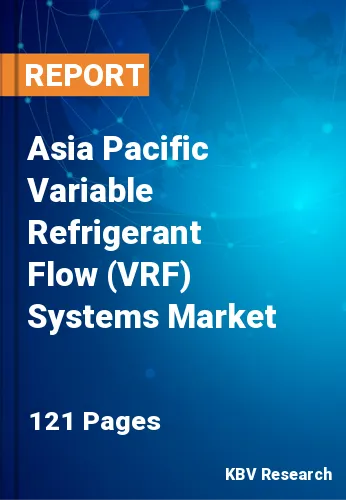The Asia Pacific Variable Refrigerant Flow (VRF) Systems Market would witness market growth of 17.5% CAGR during the forecast period (2020-2026). VRF systems are non-traditional HVAC systems compared to conventional ducted systems that circulate throughout the building in the air or chilled water. The term VRF indicates the system's ability to adjust and regulate the flow of refrigerants via multiple evaporator coils to provide individual temperature regulation in different mechanical comfort zones. VRF systems transfer the heat from the room directly to the evaporator coils located inside the conditioned space using direct expansion (DX) as part of the simple refrigeration process. In this case, the heat-transfer media is the refrigerant, which provides heating and cooling to different zones with less energy compared to air or water.
Another advantage of VRF-systems is individualized comfort. With controls on indoor units, occupants can adjust the temperature to their liking, which is why VRF is such a common choice in dormitories and hotels, for example. The VRF systems are lightweight as compared with conventional HVAC systems. For example, there is smaller refrigerant piping which works well for buildings that need tight space. Given the adaptive architecture, VRF allows simple installations and is also a good option for retrofits.
Among countries, the early adopters of the VRF technology are China, Japan and South Korea. China, which is the world's largest developing country, is experiencing a dynamic climate, increasing the country's need for efficient heating and cooling solutions. The country's latest wave of building construction has contributed to rapid economic growth and improved living standards. The growth in the construction industry has had a direct effect on the country's energy consumption.
Due to the presence of the major players in this area, APAC holds the largest market share. Countries such as China, Japan, South Korea and India are driving the VRF program demand growth in APAC to a large extent. Those countries have substantial market size and potential for VRF industry growth. The adoption of VRF systems in the APAC region is supported by various government regulations, acts, and associations.
Based on Type, the market is segmented into Heat Pump Systems and Heat Recovery Systems. Based on Component, the market is segmented into Outdoor Units, Indoor Units and Control Systems & Accessories. Based on End User, the market is segmented into Commercial, Residential and Others. Based on countries, the market is segmented into China, Japan, India, South Korea, Singapore, Malaysia, and Rest of Asia Pacific.
Free Valuable Insights: Variable Refrigerant Flow (VRF) Systems Market in Asia Pacific is expected to register a CAGR of 17.5% during the forecast period (2020-2026)
The market research report covers the analysis of key stake holders of the market. Key companies profiled in the report include LG Electronics, Inc. (LG Corporation), Daikin Industries, Ltd., Toshiba Corporation, Mitsubishi Electric Corporation, Fujitsu Limited, Trane Technologies PLC, Lennox International, Inc., Panasonic Corporation, Samsung Electronics Co., Ltd. (Samsung Group), and Johnson Controls International PLC.
Market Segmentation:
By Type
By Component
By End-User
By Country
Companies Profiled
Our team of dedicated experts can provide you with attractive expansion opportunities for your business.

